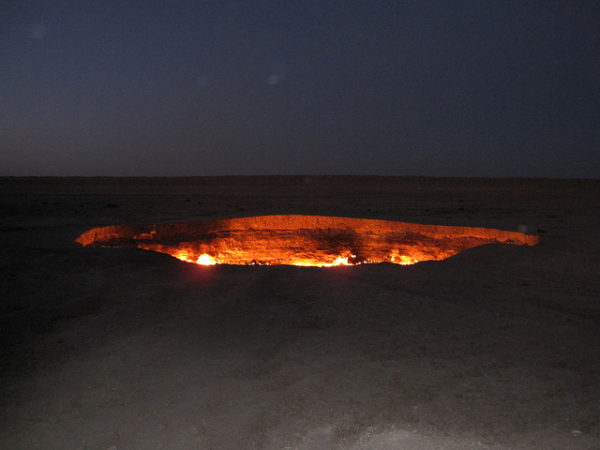It is in the middle of Turkmenistan, alone in the centre of the Karakum Desert, an endless fire rages. At the bottom of a 70-meter-wide (230 ft) crater, surrounded by the stark expanse of barren rock and sand, flames burn in a ceaseless and hellish-seeming natural wonder. The anomaly is truly satanic is appearance, unsurprisingly earning this fiery pit the nickname the “Door to Hell”. Imagine wandering through the Karakum at night, with endless black stretching out in every direction, only to come across this rumbling beast: it would be easy to imagine you had stumbled upon Hades, or that some terrible fiend had recently broke through from another realm.

The Darvaza Gas Crater, as it’s officially called, has an origin story dating all the way back to 1971. Whilst this is a modern date for something that carries such a sense of mythos, the remarkable fact is that this giant fire has been burning non-stop since then – that’s almost 50 years! What’s more, there’s no clear sign of when the fire will go out, or if it ever will.
The area around the Darvaza crater, as its official name suggests, is rich in natural gas. Whilst conducting exploration drilling in 1971, Soviet geologists tapped into a cavern filled with this gas: however, the floor beneath their rig collapsed, swallowing it as the area fell in on itself. The 70ft crater now posed a threat, as the geologists knew there was a high chance of poisonous gas discharge being released into the desert. Their fast solution was to set fire to it – seems risky, right? – hoping that any excess would quickly burn away. The pit ignited, and the scientists expected the flames to die down after a couple of days – but the days kept going. They turned into weeks, into months, and now, 47 years later, they burn on in defiance.
Unsurprisingly, as news spread, the tourists came. A good 30 ft deep, the crater glows in a way that seems almost molten, an aggressive image in the middle of the most void and barren of landscapes. If you were to picture a pit to hell, this is exactly what you would imagine, and even though its explanation is known, one can’t help but marvel at such a supernatural-seeming event. Even on a scientific level, the sight is awe-inspiring – a reminder that the Earth still has surprises to throw at us.
The crater’s official name is a nod to the village that lies near it. Darvaza, or Derweze, homes about 350 inhabitants in a small settlement nestled right in the middle of the Karakum Desert. These residents are mostly Turkmen of the Teke tribe, and are one of the few groups preserving the tribe’s semi-nomadic lifestyle. The village’s true name, Derweze, derives from the Persian for The Gate – another nod to the area’s infamous attraction.
However, the Door to Hell has had a tragic negative impact on this nomadic village. In 2004, partly in response to the growing tourist attention that the burning pit gathers, the President of Turkmenistan ordered that the village be disbanded, because “it was an unpleasant sight for tourists.” Whilst still attempting to live in the area, life for this village has been complicated by the attention the crater has received.
Yet, for Turkmenistan as a country, the attention from overseas has been profitable – even if the crater has made it unsafe to drill for oil and gas in this resource-rich desert. It’s perhaps to be expected that something this devilish would be a duel blessing and a curse. Who knows if it will ever burn out, but until it does, it has to be seen to be believed.







